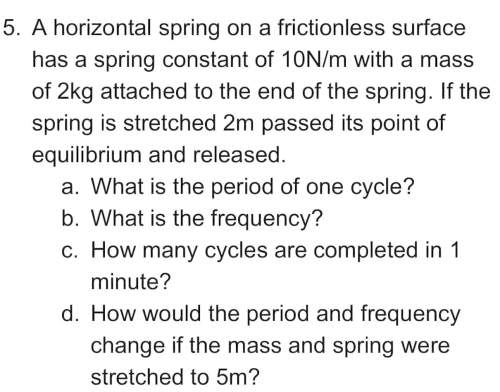
Physics, 10.09.2021 17:50 chasidystanford56
The friction force of a 200 N wagon being pulled across the road that has a coefficient of friction (n) of 0.25

Answers: 2


Other questions on the subject: Physics

Physics, 22.06.2019 15:30, Mhayslett12
To understand the electric potential and electric field of a point charge in three dimensions consider a positive point charge q, located at the origin of three-dimensional space. throughout this problem, use k in place of 14? ? 0. part adue to symmetry, the electric field of a point charge at the origin must point from the origin. answer in one word. part bfind e(r), the magnitude of the electric field at distance r from the point charge q. express your answer in terms of r, k, and q. part cfind v(r), the electric potential at distance rfrom the point charge q. express your answer in terms of r, k, and q part dwhich of the following is the correct relationship between the magnitude of a radial electric field and its associated electric potential ? more than one answer may be correct for the particular case of a point charge at the origin, but you should choose the correct general relationship. a)e(r)=dv(r)drb)e(r)=v(r)rc)e(r)=? dv(r)drd)e(r)=? v(r)r
Answers: 2

Physics, 23.06.2019 00:30, spenceraniyah1
What is the technical name for super glue type adhesives?
Answers: 3

Physics, 23.06.2019 02:50, steves9994
You are your friend move a new refrigerator into his kitchen. you apply a horizontal force of 252 n in the negative x direction to try and move the 56 kg refrigerator. the coefficient of static friction is 0.61. (a) how much static frictional force does the floor exert on the refrigerator? give both magnitude (in n) and direction. magnitude n direction (b) what maximum force (in n) do you need to apply before the refrigerator starts to move?
Answers: 1

Physics, 23.06.2019 08:30, rocky8875
[05.02] what is the best explanation of the kinetic molecular theory as it relates to the energy of the molecules in the states of matter? (1 point) the molecules in a gas have greater kinetic energy than those in a liquid, which in turn have greater kinetic energy than the molecules in a solid. kinetic energy cannot be created nor destroyed, and, as a result, all states of matter have the same kinetic energy. the molecules in a gas have greater kinetic energy; therefore, they are more tightly packed than the molecules in either a liquid or a solid. the molecules in gases and liquids, in constant motion, have greater kinetic energy than those in a solid, which do not move or vibrate because their position is fixed.
Answers: 2
You know the right answer?
The friction force of a 200 N wagon being pulled across the road that has a
coefficient of frictio...
Questions in other subjects:

Mathematics, 26.06.2020 17:01

Mathematics, 26.06.2020 17:01



Geography, 26.06.2020 17:01

Computers and Technology, 26.06.2020 17:01

Mathematics, 26.06.2020 17:01


History, 26.06.2020 17:01

English, 26.06.2020 17:01




